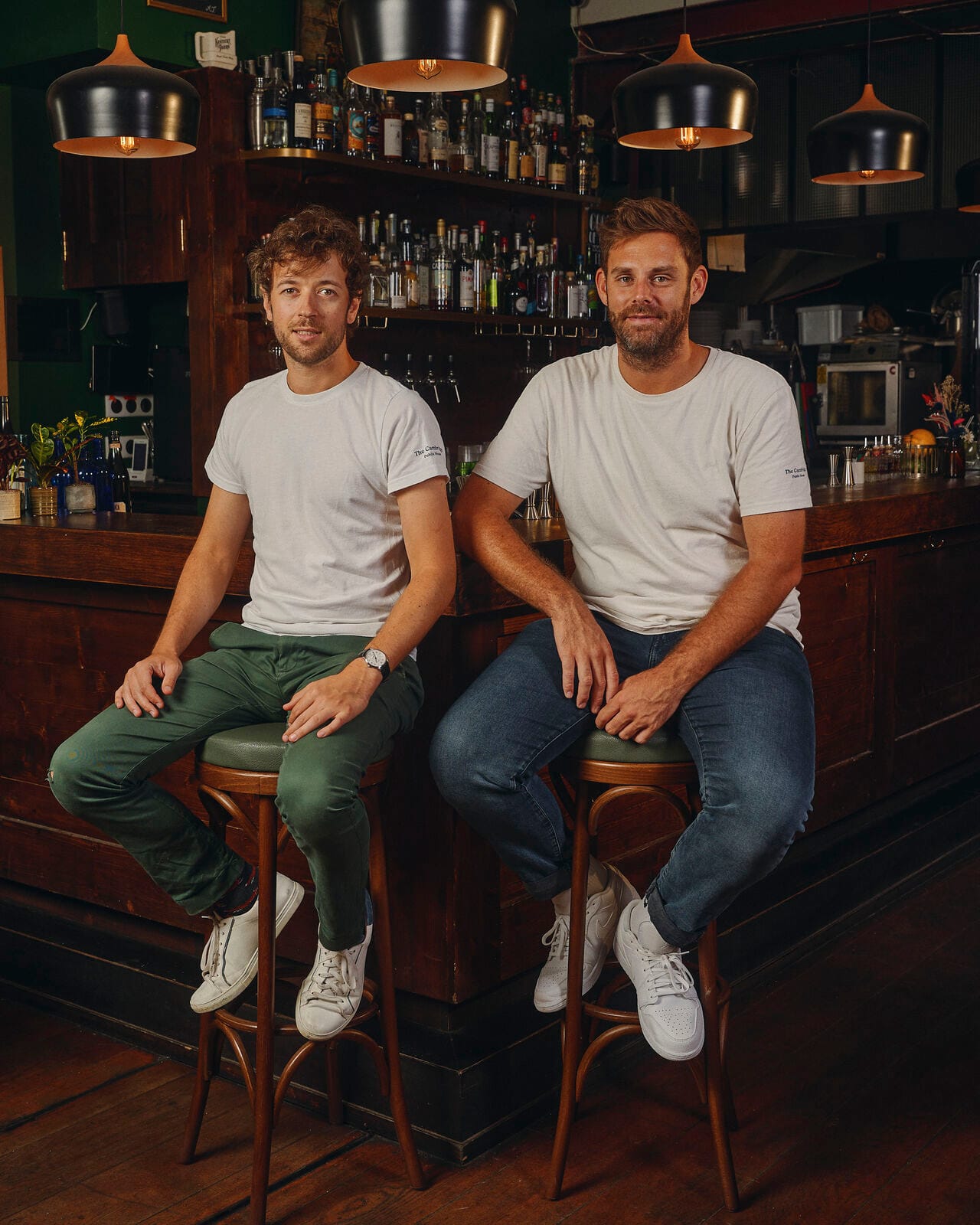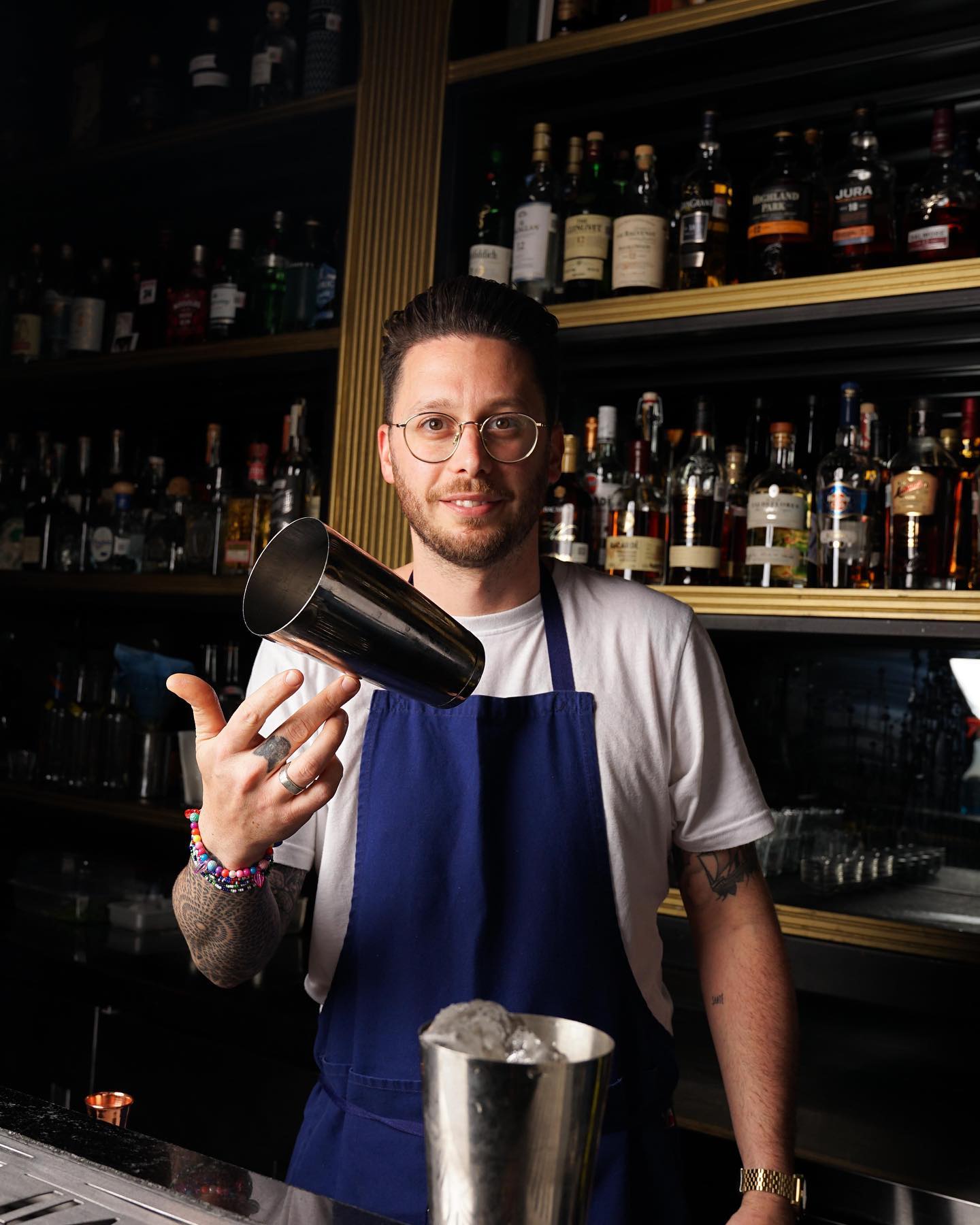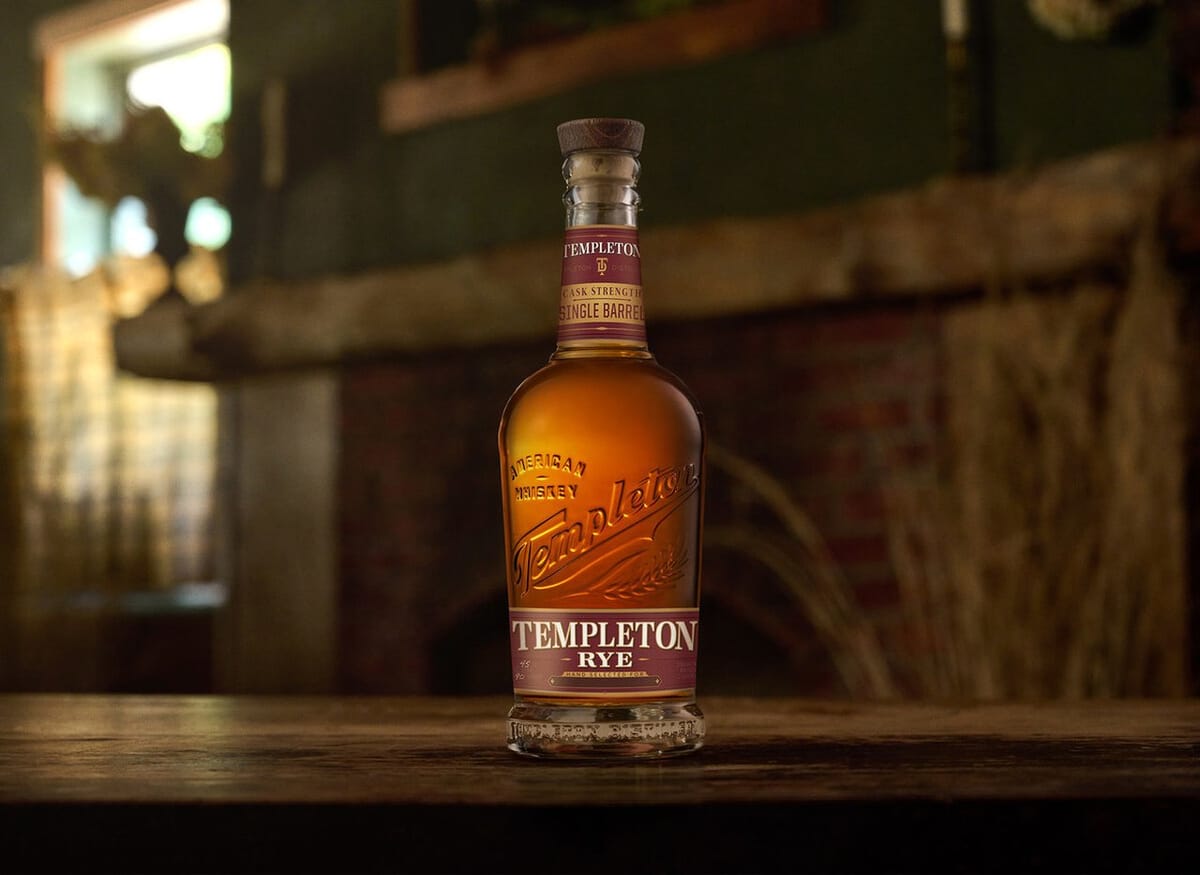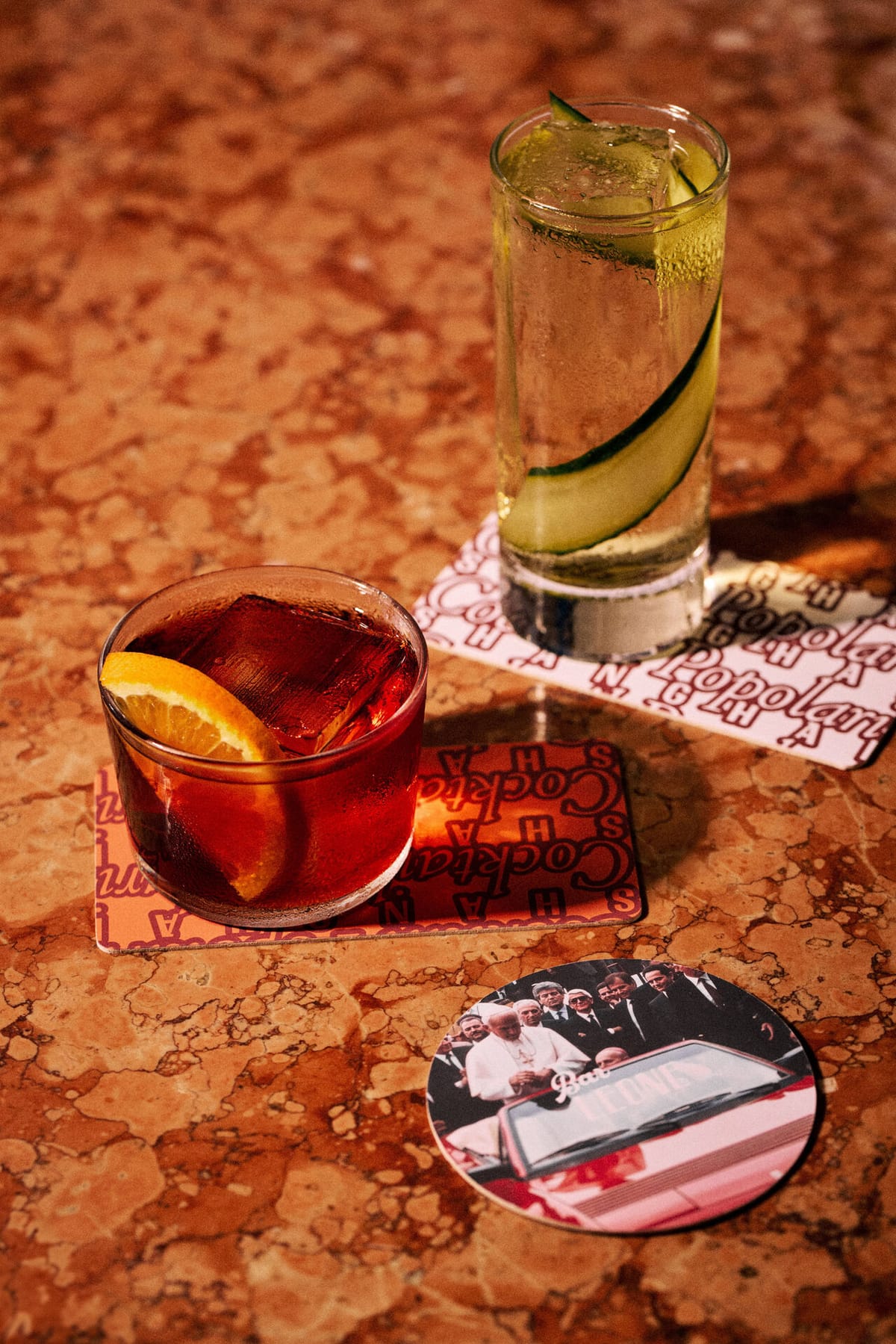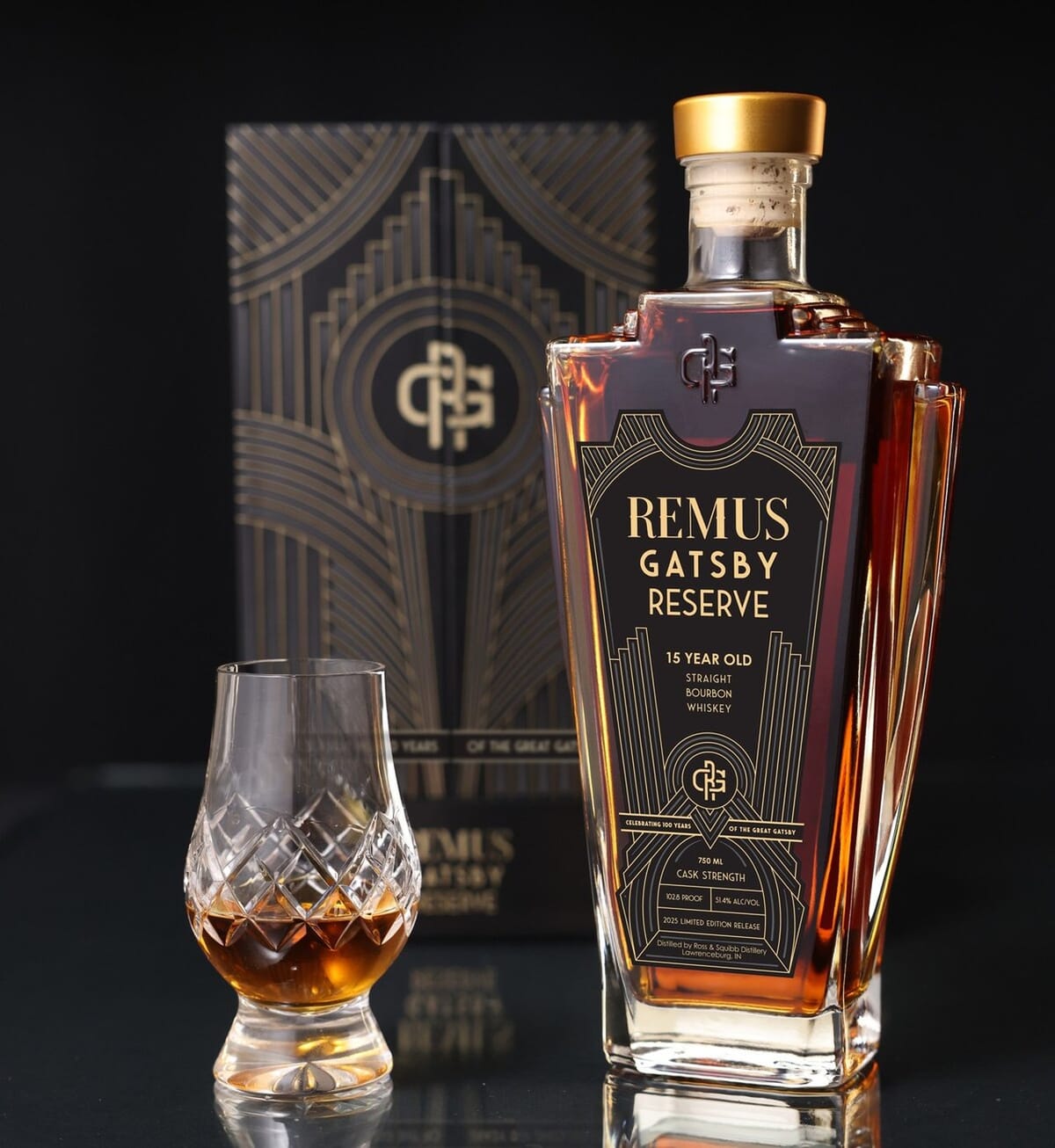Behind the counter at the Cambridge Public House with Nicolas Goradesky
The Cambridge Public House is internationally recognized as one of Paris’s top bars. Bar manager Nicolas Goradesky tells Jigger Daily about its seasonal cocktails, ties to Little Red Door post-acquisition, and its steady rise on the 50 Best Bars list.
Tiny Cocktails
The Cambridge Public House is an English pub with cocktail expertise. Our menu never changes in its entirety and is largely based on a seasonal cocktail offer.
On the cover page stands the cocktail of the week. Then we have the Tiny Cocktails – which we also call cocktails amuse-bouche – with three recipes introduced two years ago. The idea came from several bars around the world, notably Handshake Speakeasy during a trip to Mexico with Hyacinthe Lescoët (ed. note: co-founder of the Cambridge Public House), and we quickly realized it was the perfect fit. Actually, this concept works really well. They’re batched cocktails, each with a distinct flavor profile.
It always begins with a Gimlet—this time made with rye instead of gin. The second is invariably a Martini style — at the moment, a fifty-fifty balance, with a rather Japanese inspiration: sake, umeshu, and a bit of ponzu. The third one, which is the booziest, is based on a Manhattan but uses rum, with a small blend of aperitifs, including Noix de Saint-Jean plus a little sesame oil on top to add some complexity.
The recipes are meant to be quite approachable so customers can analyze the cocktail and get something quickly – that’s why we batch them – while they delve more deeply into the menu, which is particularly extensive.
However, the original purpose has been somewhat diverted, and some patrons order the full trilogy. In that case, we suggest drinking them in the order they appear on the menu. Sometimes they ask for these cocktails in a standard size. And sometimes, guests order a Tiny with a beer—like a Boilermaker, but with the cocktail instead of a shot.
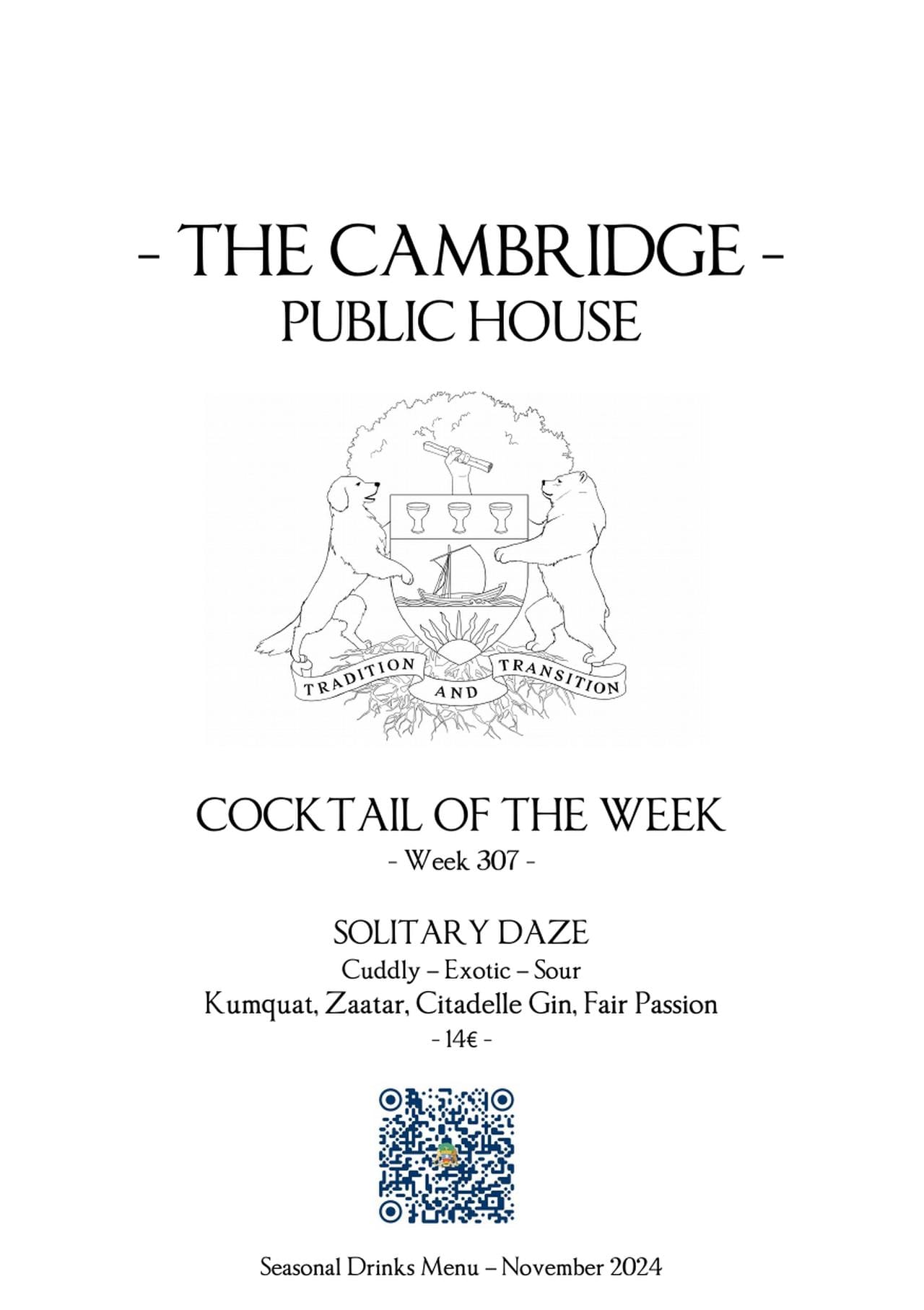
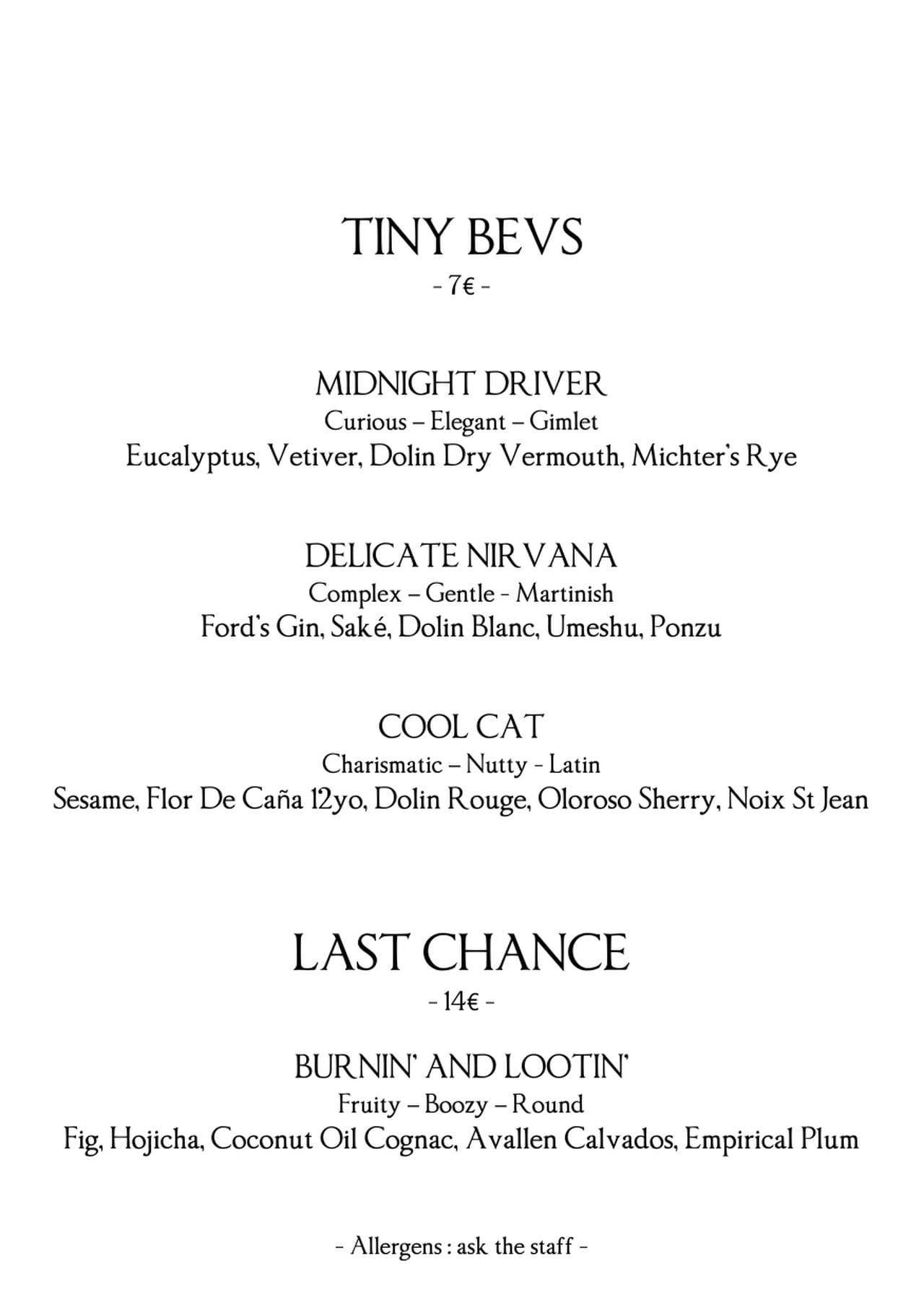
Last Chance
A section of our menu is called Last Chance. Since we regularly change our offerings – at least one cocktail a week – the bar was left with a lot of surplus ingredients we couldn’t use. That’s why we have a section letting customers know a cocktail will only be available for a few more days.
One recurring anxiety for a cocktail bar is being sold out. When a bartender introduces the menu to guests, there’s a certain amount of information to share, and it’s always frustrating to start by saying, ‘sorry, we’re out of that cocktail tonight.’ This issue doesn’t arise with the Last Chance section. If, after three days, none of that cocktail is left, we stamp game over on the menu so customers immediately understand it’s gone. We specifically created this section to cut down on waste, because it’s hard to predict exactly how much prep you’ll need when you’re rolling out new recipes every week.
We don’t really publicize this, but €2 from each cocktail in this section goes into a small fund to support various organizations. Last time, it was to help bars in Turkey after the earthquake.
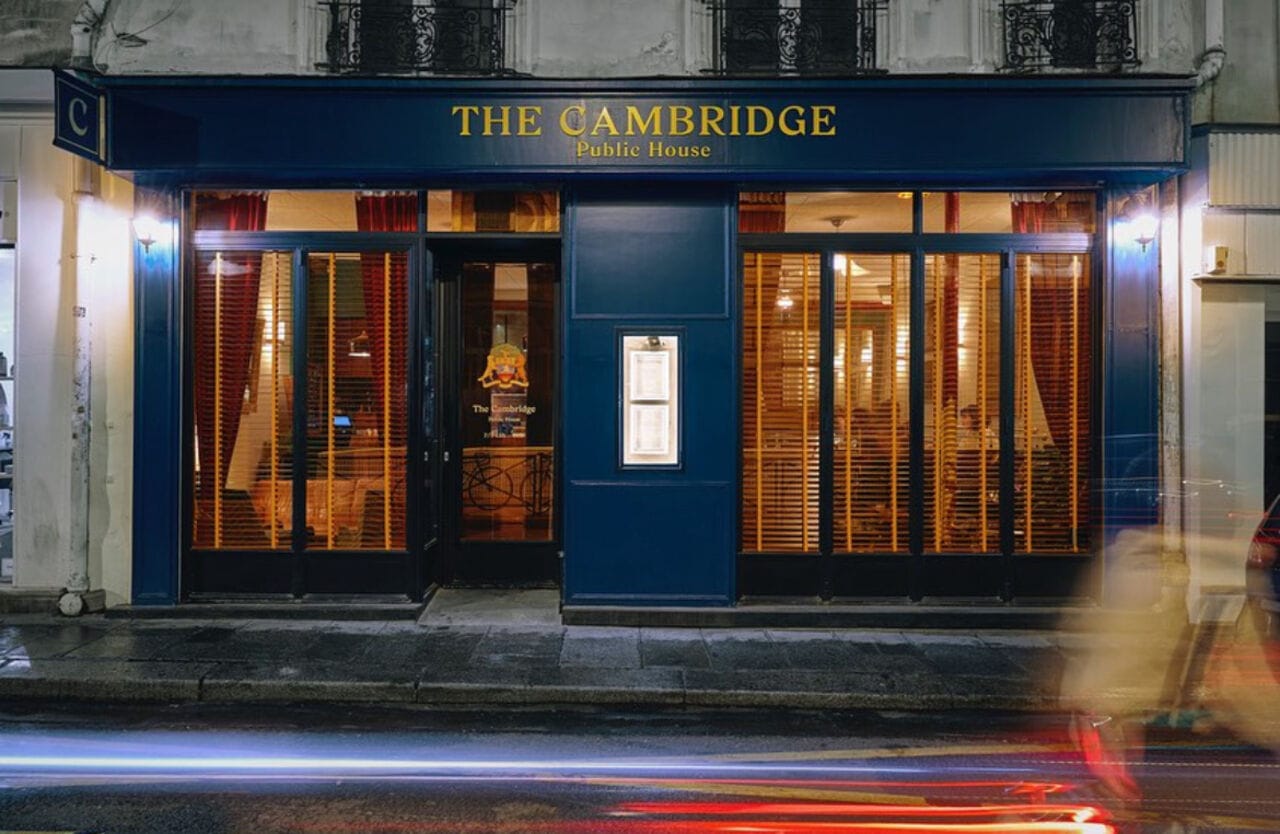
Cigarette After Sex ?
The Cigarette After Sex has been on the menu since day one. Its recipe isn’t dictated by seasonality. This cocktail is somewhat inspired by Mexican culture, based on mezcal, a little sloe gin, and agua de Jamaica, an infusion of dried hibiscus flowers – reminiscent of bissap – sweetened with agave. At the Cambridge, we like to use French honey and a touch of verjus for acidity. I believe if this drink naturally imposed itself on our menu, it’s first of all for its practical side, not being dependent on seasonal changes. Secondly, it’s quite unusual in taste: it’s a Long Drink that’s refreshing yet full of character. The mezcal provides some length on the palate. Moreover, when we first created this cocktail, the general public didn’t really know mezcal. It’s a bit more familiar now, but still very much in the industry realm. The flavors can be quite surprising for French patrons, as well as foreign visitors like Asians. I think it’s always important to have a signature cocktail as a reference point in a bar. Even more so when the menu changes frequently. In fact, when we explain our menu to customers, we always introduce Cigarette After Sex as the cocktail from the very first Cambridge Public House menu, which also allows us to talk about our focus on seasonality.
Our second signature cocktail is the Pimm’s, now in its 6th iteration… as it changes almost every year. It’s a twist on a Pimm’s Cup with a different wine each year, as well as a different gin. It’s a batched cocktail, with the dilution added before carbonation, and served in the style of a Pet Nat (ed. note: natural sparkling wine). The idea here is to create a wine-based cocktail that nods to French culture. It’s also a nod to our small selection of wines on the menu.
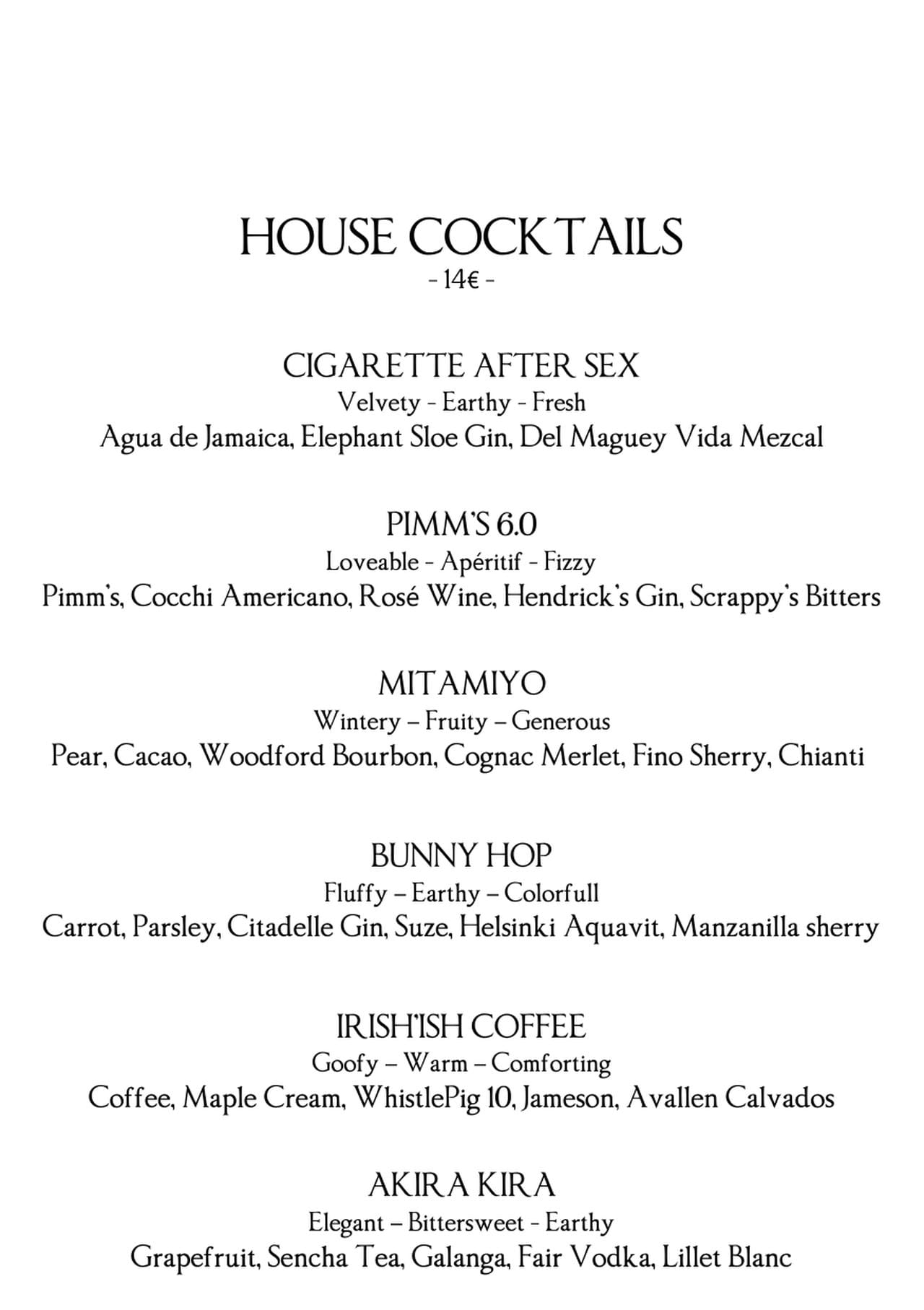
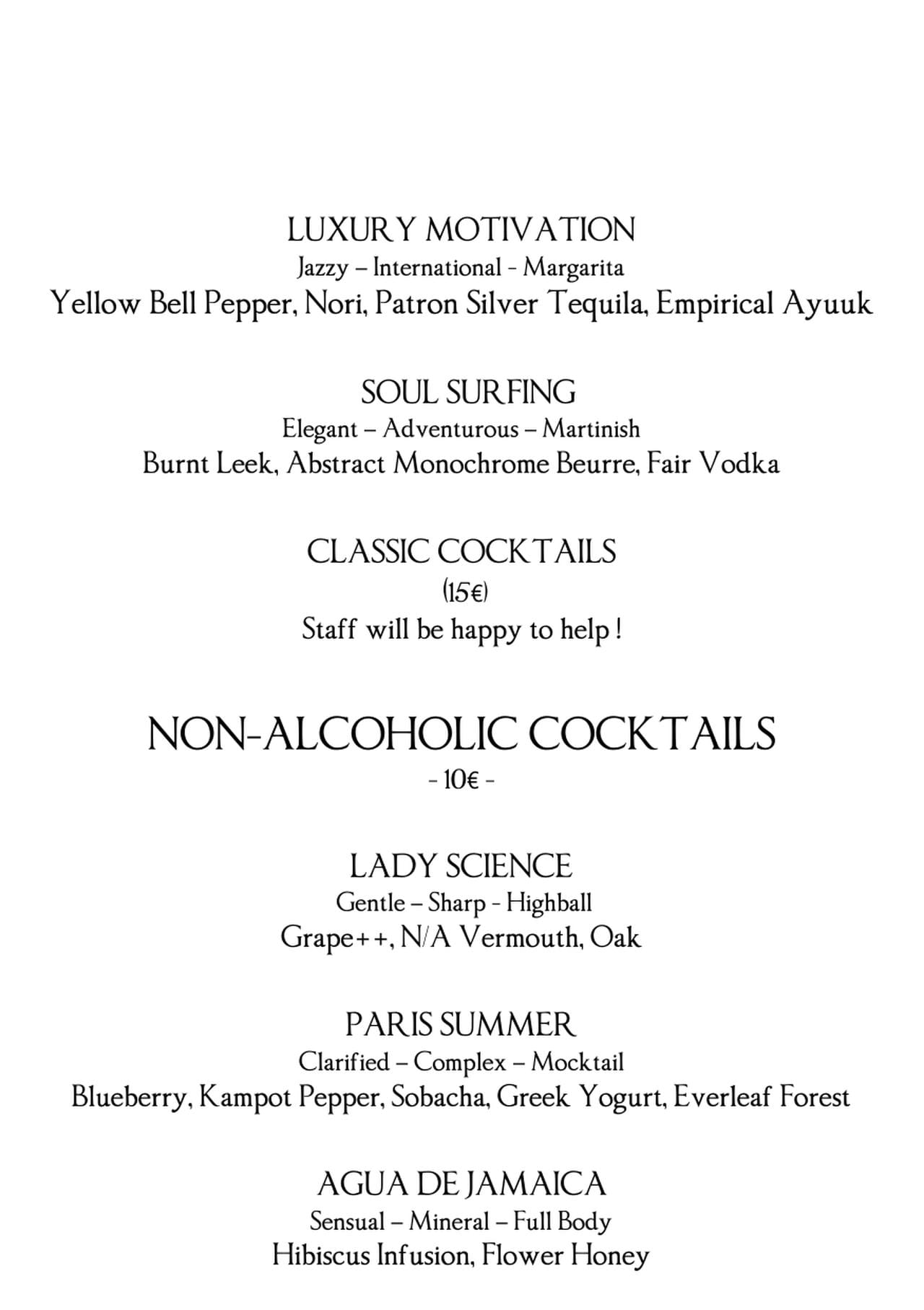
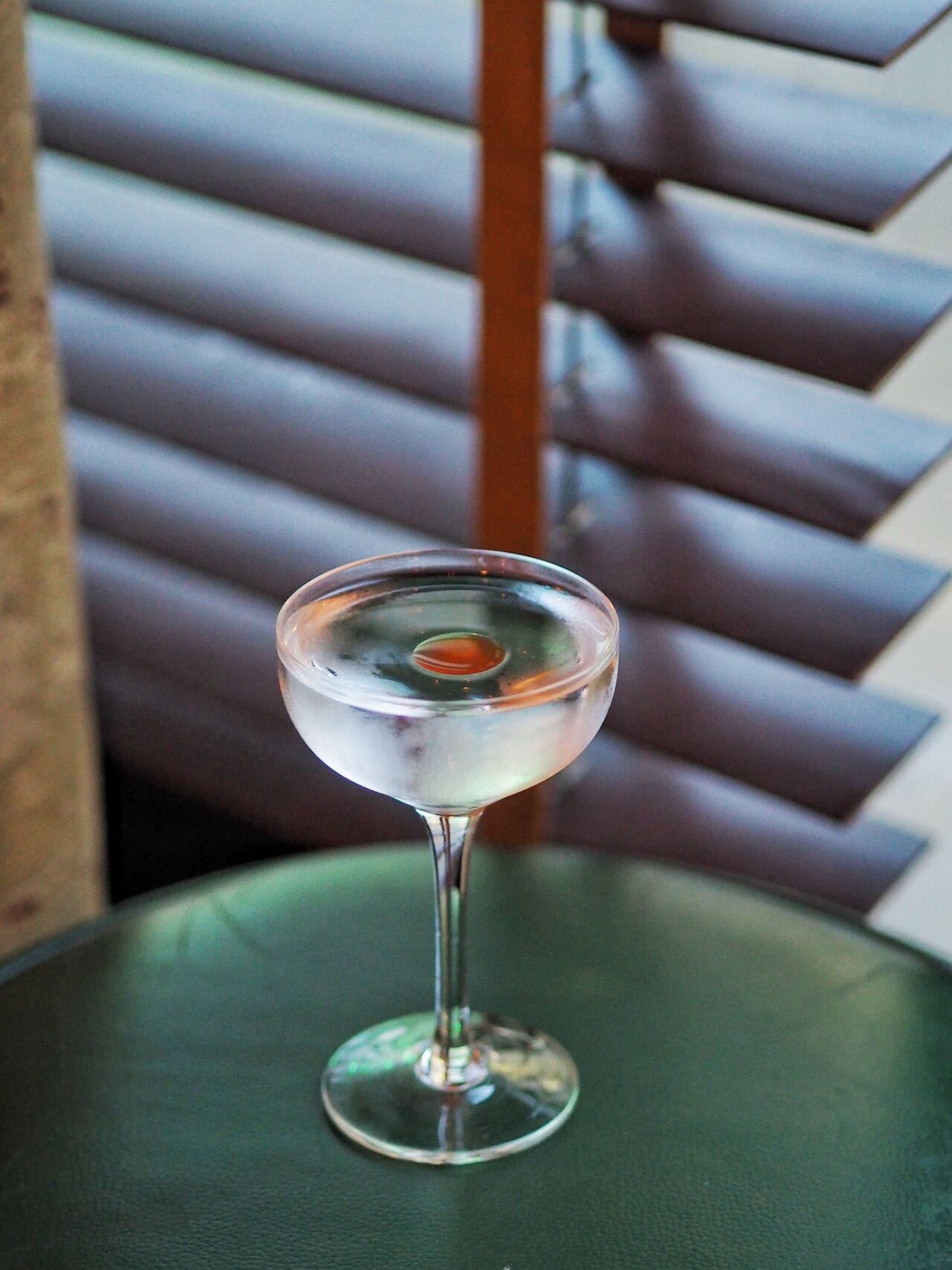
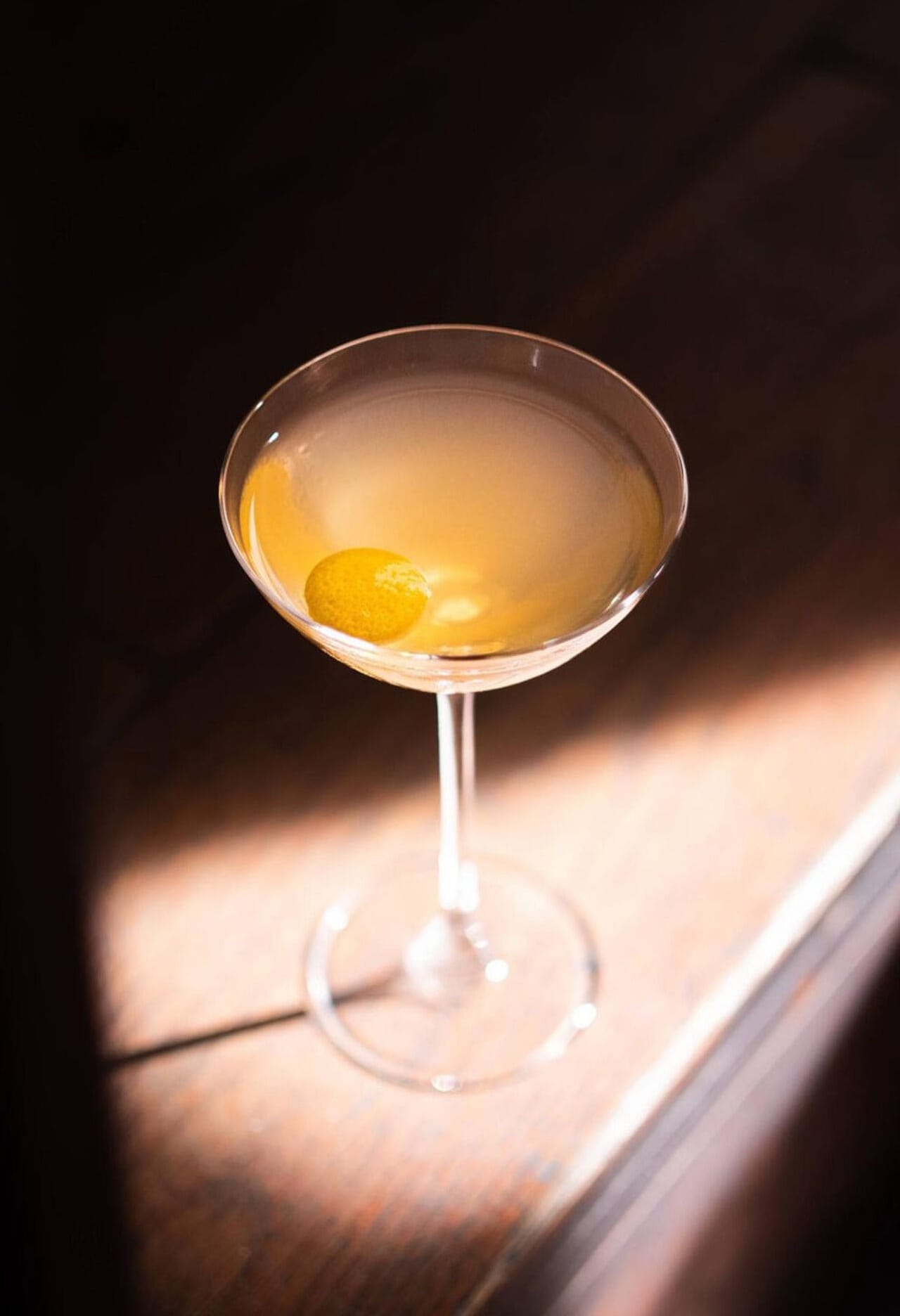
Soul Surfing & Akira Kira
A Menu Inspired by Seasonality
All the other cocktails showcase a seasonal ingredient. As soon as the season is over, or we can’t find it in France anymore, it’s easy for us to phase it out, because the format is easily updated. We don’t need to reprint an entire menu or redesign it, as we change the cover page – made with recycled paper – every week.
Sometimes, when an ingredient has a super short season, the bar might decide from the outset to feature it as the cocktail of the week. The other option is to keep a large amount of the ingredient bought at the right time. For instance, last year we got a sizeable stock of mirabelles, which we then left to infuse for six months in a cocktail similar to El Presidente. Granted, the drink was released off-season, but it used an ingredient obtained at peak quality.
Furthermore, eco-responsibility pairs well with the idea of seasonality. I think it’s simply a smarter way to work. Obviously, the cocktail bar didn’t invent this concept. In the kitchen, top chefs have always aimed to source the best product. Naturally, that product is at its best when it’s in season.
When you’re looking for premium spirits or liqueurs, sourcing top-quality ingredients at their flavor peak is a logical approach.
When we travel and host master classes about the Cambridge to explain our creative process and menu, we always clarify that this approach works for us because we’re in France, with local, varied, and seasonal products.
In contrast, it might not work in somewhere like Singapore, where all ingredients are imported and available year-round without interruption. A seasonality-centric menu would therefore be irrelevant, so they focus on other aspects of their menus.
Maybe a menu based on seasonality isn’t the best concept for some, but we like it, and the Cambridge Public House has stuck with it since opening; we’re carrying on the tradition. One of the most exciting aspects is rediscovering the same produce each year but always creating new recipes.
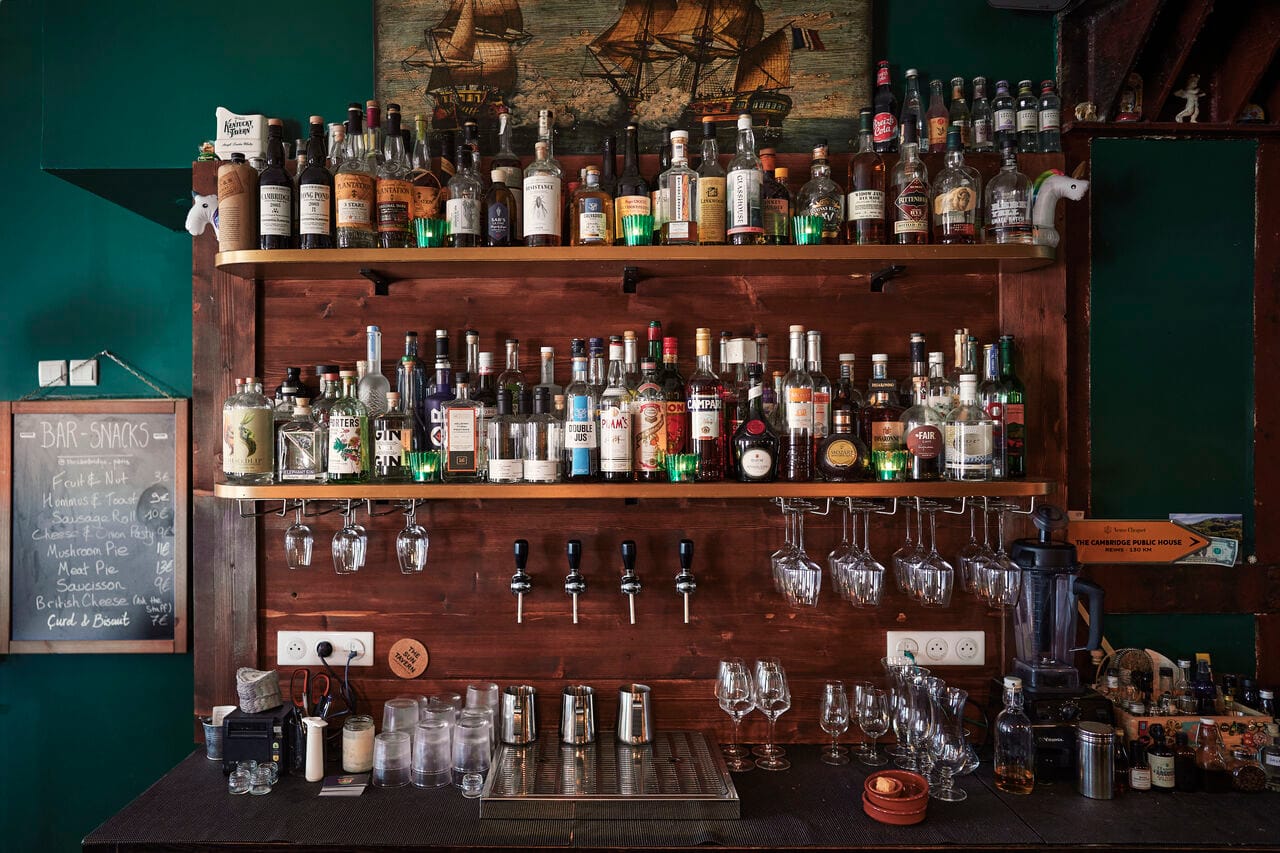
Pre-batch and Sustainability
We batch a lot of the spirits with other liquids to cut down our movements and boost speed and efficiency, but it’s true that a bar should feel alive. There’s a show element we can’t forget. That’s why we’ll always offer at least one shaken cocktail on the menu – at least a Sour– as well as stirred recipes.
Even so, our guiding principle is to minimize waste. We use many vacuum bags for storing our preparations or when traveling, which generates plastic waste. By digging a bit, the team found an alternative with compostable vacuum bags.
We started composting nearly three years ago with a company called Les Alchimistes. They come pick up our bin every week. It shows that by imposing a few constraints on ourselves, especially regarding eco-responsibility, we can find solutions by being creative.
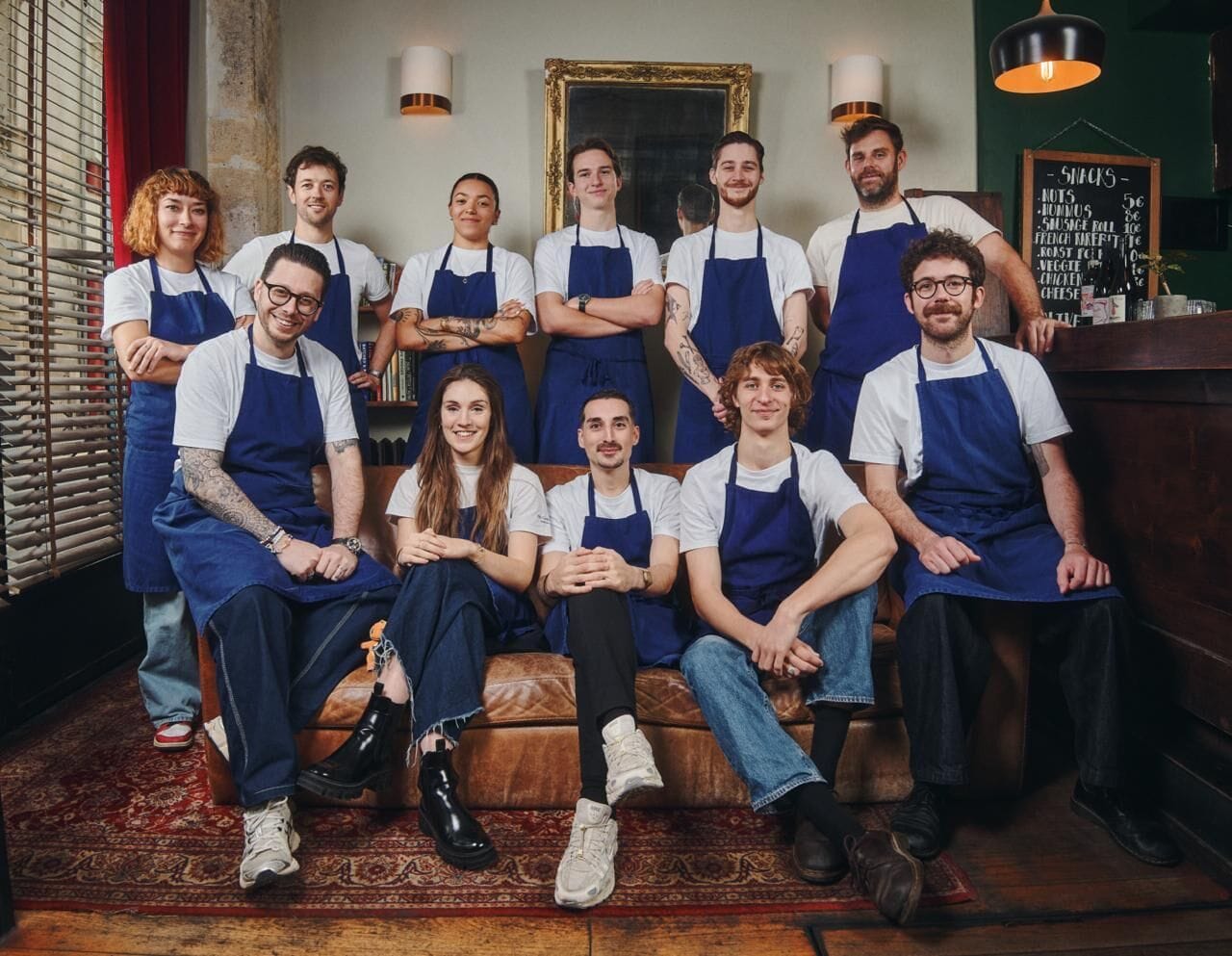
Relationship with Little Red Door
The arrival of Little Red Door into the group is still recent, as it dates back to July. Our intention is to keep them as two distinct entities, with no crossover between teams. They’re two different bars, each with its own vision. Hyacinthe and I keep an eye on what’s happening there, holding meetings every Thursday, and I’m lucky enough to focus on the creative side of the menu. The seasonality principle is present at the Little Red Door as well, but the menu is handled differently. It’s designed for three months, choosing five ingredients with a fairly long season (like pear or apple).
Hyacinthe worked heavily on the first concept of the Little Red Door menu, called Twisted Mirror, the distorted mirror. It’s inspired by what was done when the bar first opened – a strong attachment to the classics – and by the last menu: Farm to Glass by Alex Francis and Barney O’Kane (ed. note: now running Bar de Vie and Comptoir de Vie). It’s a mix of both, featuring five international classics, made to the best possible recipe, and in a mirror, a 100% French version with a seasonal product. The goal is to reboot the place a little.
The venue will probably get a slight refresh as well. The Little is now 12 years old and sees around 300 to 400 people a night. It’s a bar that has received significant recognition and a lot of international coverage, and its clientele can be up to 80% tourists.
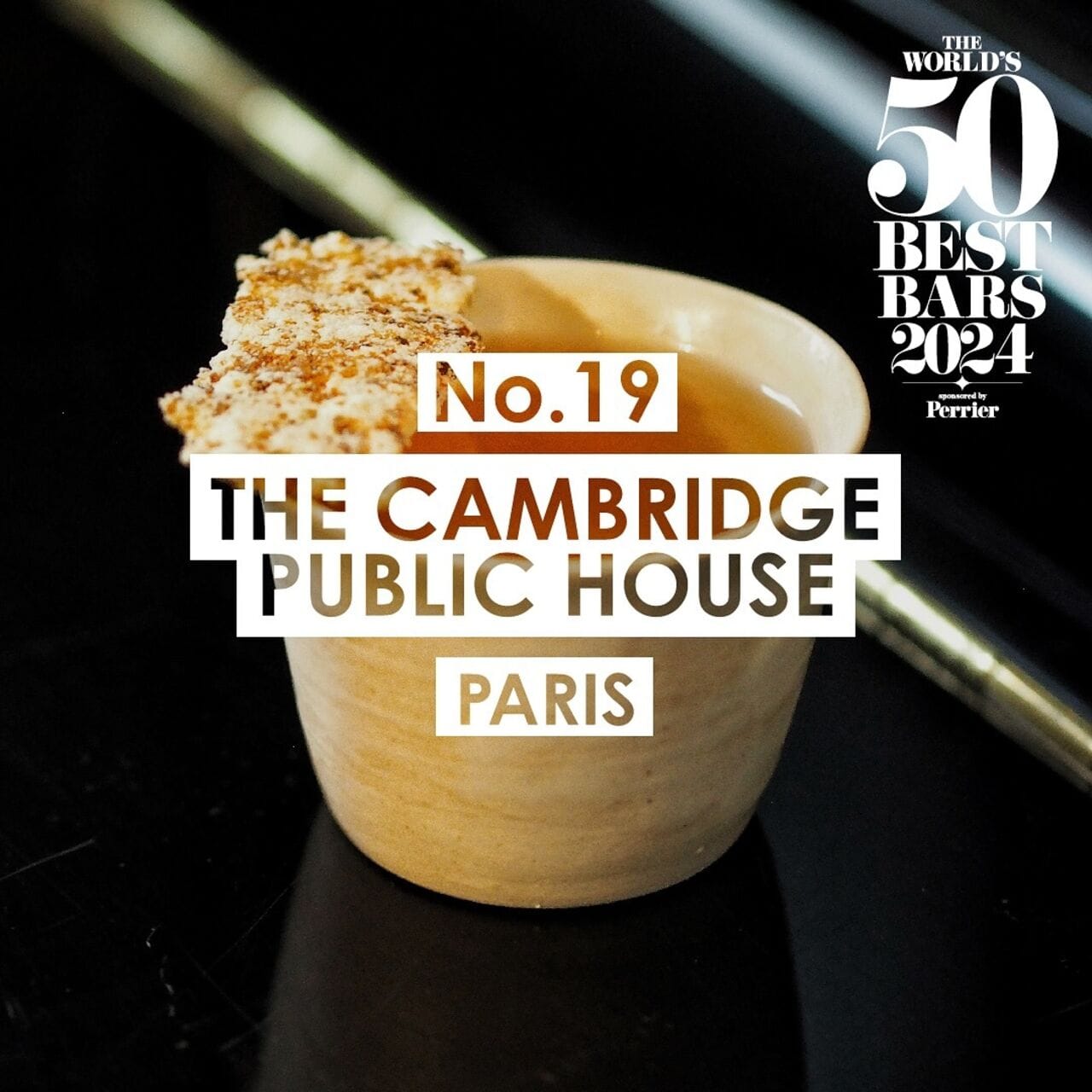
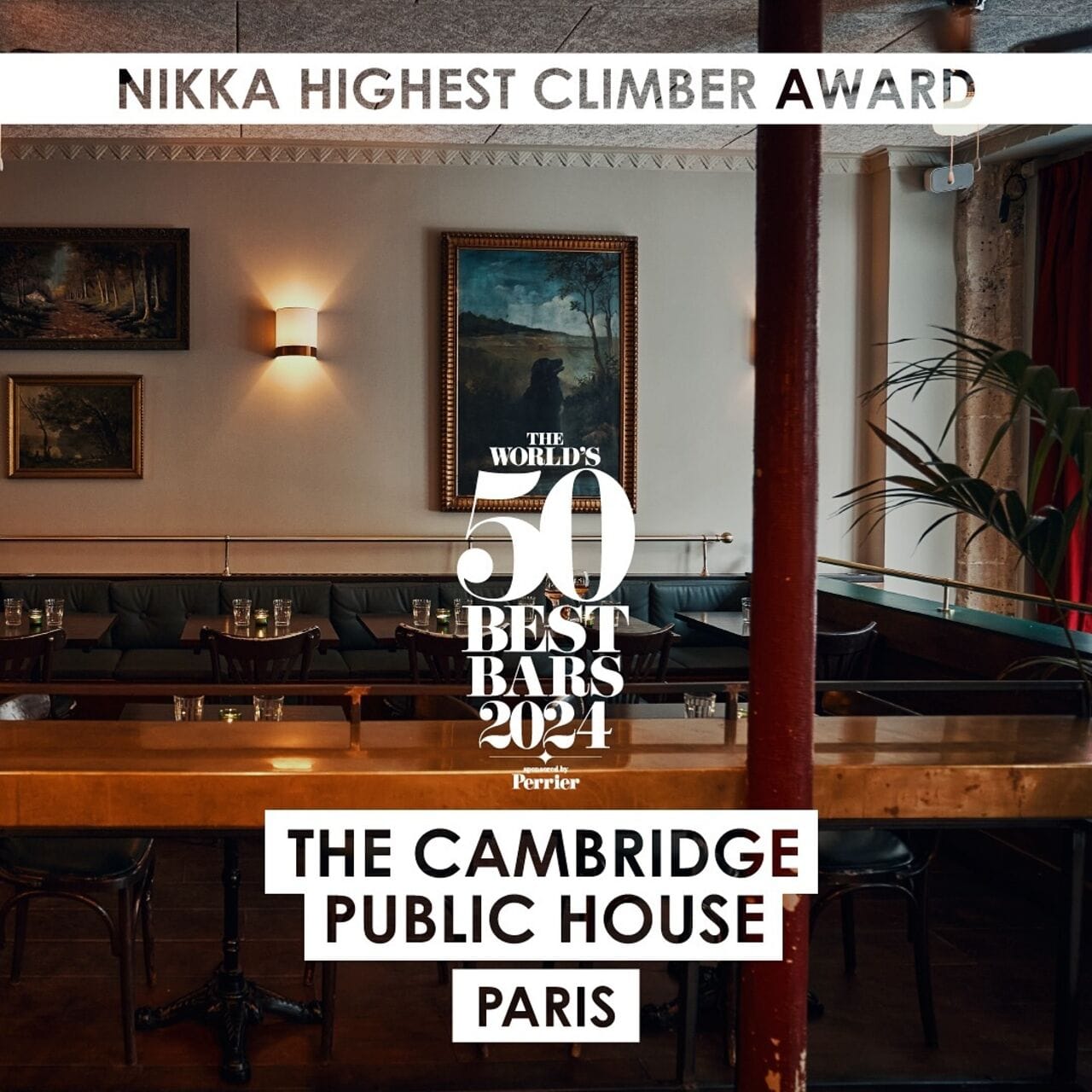
Biggest Climb in the 50 Best Bars 2024 Ranking
I don’t think there’s a magic recipe for moving up in the 50 Best Bars ranking. When the results were announced, we were both surprised and delighted. There are a lot of current international bar trends, including a return to a bar style like the Cambridge Public House – more relaxed, laid-back, so-called “neighborhood focus.” That’s been our concept from the start, and it lined up well with the moment. Keep in mind many industry people vote, and they’re currently looking for more casual spots.
At the Cambridge Public House, we’ve got a neighborhood, friendly, fairly chill vibe that we want to maintain.
Previously, very conceptual bars were trending, sometimes with over-the-top recipes. Maybe that’s partly due to a sense of saturation with so many cocktail bars offering essentially the same thing: very clean, always clarified drinks with frequent use of the Rotavap.
We have our own cocktail “signature,” which is a bit different. We do use modern bar techniques, but we also want to retain certain elements. In that sense, our crest, with the words ‘Tradition et Transition,’ really encapsulates our cocktail philosophy. Sure, the bar has a Thermomix, immersion circulators for sous-vide cooking, but a Rotavap has never really fit the concept of our drinks.
It’s probably one of the keys to Cambridge’s success: the style of our cocktails is now well established, and we haven’t veered from that path. Our progression in this year’s 50 Best is the result of a trend and good timing.
A 50 Best Bars ranking brings a lot of visibility, which is very important for a business. Of course, it shouldn’t be the main goal, but it does greatly help. As soon as the results were published, the Cambridge Public House was busier than ever; plenty of guests visited to congratulate us. For travelers, it’s become a real go-to spot… whether they’re Anglo-Saxon or Asian. The Chinese seem to be paying attention now. Even in France, many media outlets pick up the rankings more willingly, and French guests mention them to us too.
I’d love to see French bars outside of the capital appear in the rankings one day. We should be talking about the French scene, featuring other cities. Lyon has a great cocktail culture, and newcomers like Povera in Nice demonstrate that, too. It’s harder, because the type of traveling clientele interested in cocktails tends to favor Paris. Yet places like Symbiose in Bordeaux offer amazing cocktails – and cuisine. Right now, they’re less visible, but I truly hope that changes someday; I’m sure it will.
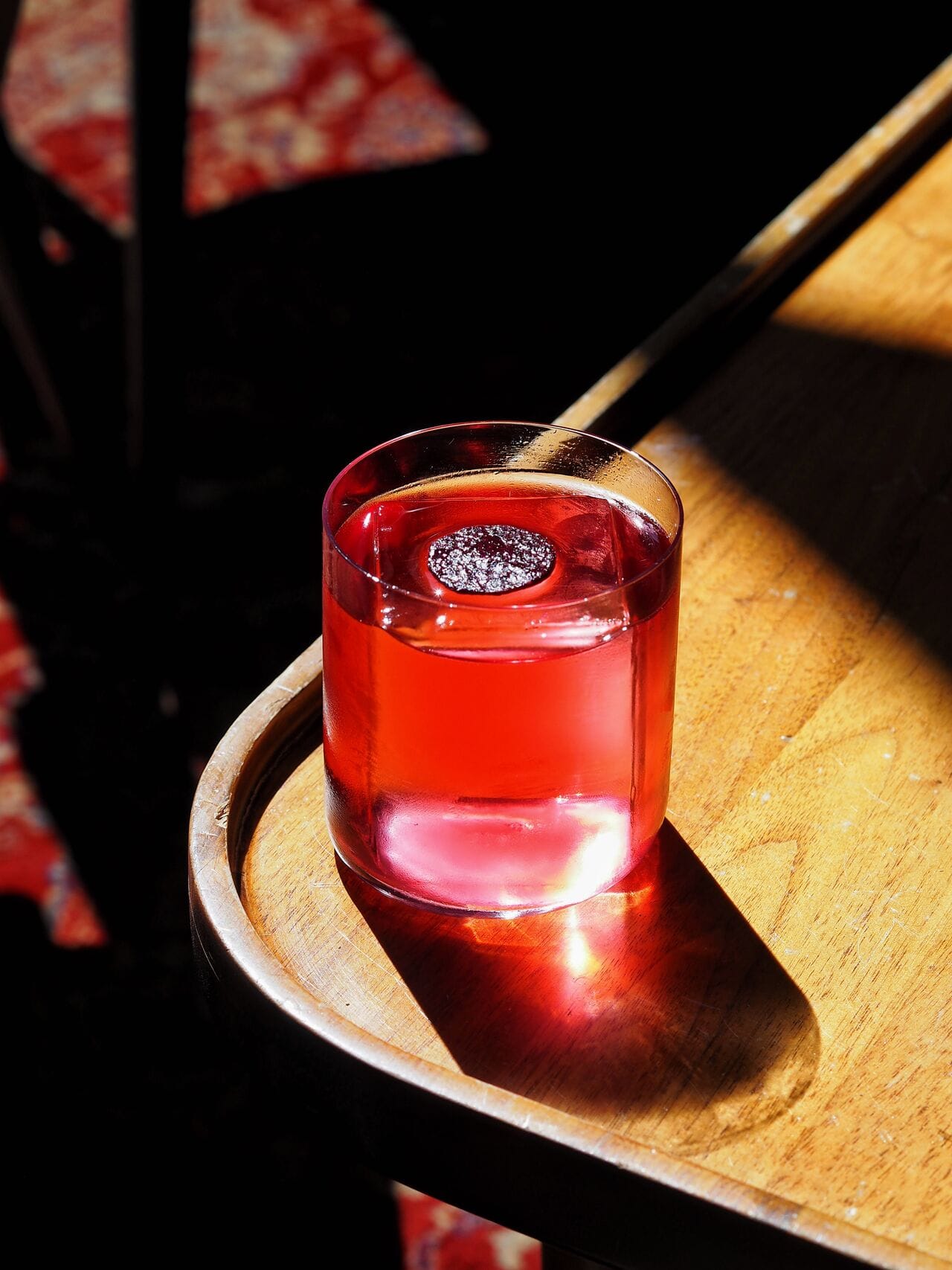
Tips for a Successful Opening
I’d advise, first and foremost, not to make the 50 Best the main objective, especially for a new bar. I’ve helped open a few places myself, and ensuring the strength of your business should be the priority. If you’re successful, you can then devote more time to international visibility, but that requires lots of travel and events.
Having a solid base is undoubtedly the key, because you have to be ready. Getting recognized in a ranking like this immediately boosts your revenue by 20 to 40%. So if you’re not comfortable with operations, if your whole team isn’t well-prepared, it can quickly become overwhelming and you’ll find yourself underwater. So, to sum up, it’s important to have a strong foundation and also to foster a sense of community. That’s something you see a lot in the bar world, particularly in Paris where we’ve always been lucky to have a tight-knit community. Everyone knows each other, helps each other. We all keep a list of recommended bars to send customers to. In London, it’s more competitive: when you ask a bartender for a recommendation, they’ll point you to a venue within the same group or suggest you keep drinking at their bar.
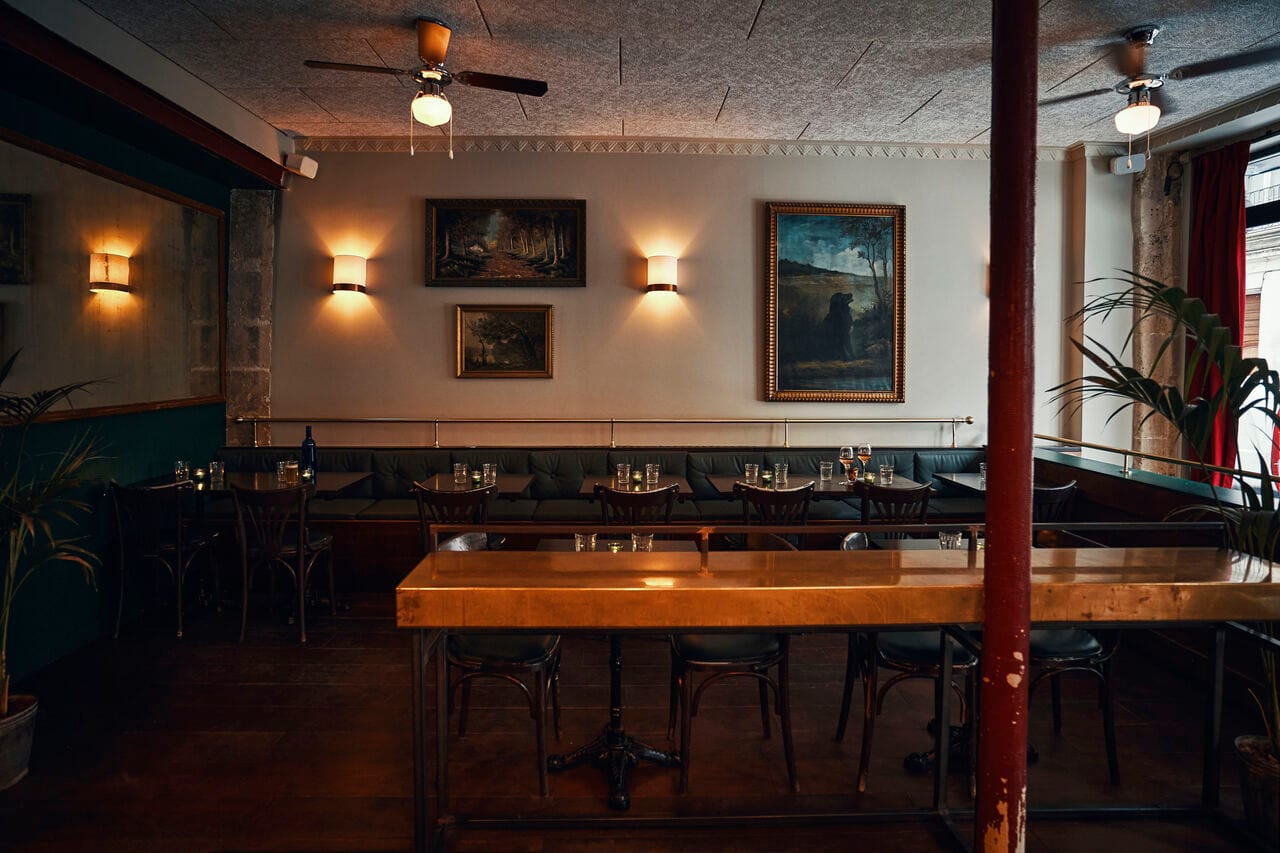
A Journey from Eden-Roc to Bisou
I’ve always been immersed in the hospitality industry. Not necessarily cocktails, but restaurants – I studied cooking at a hotel school in Nice. I discovered bartending somewhat by chance, and I loved it right away. My parents were restaurateurs who bought a new place in Saint-Raphaël and asked me to work with them. It was a great five-year experience, very formative. I was very young and enthusiastic, watching videos online and reading every cocktail book I could get my hands on…, while making short trips to London in search of something new for the South of France.
Afterward, I felt the need to travel and spent just over a year in Hong Kong, where I discovered great cocktail bars – like you find in London – in a very international atmosphere. I really absorbed that strong cocktail culture, especially the hotel bars.
When I returned, I spent some time at the Hôtel du Cap-Eden-Roc, in Cap d’Antibes, which was also very instructive. However, as it’s a seasonal place, come autumn, I found myself looking for a new job. So I decided to move to Paris and got in touch with Jérôme Kaftandjian, also from the South and already in the capital. He put me in contact with Nicolas Munoz, who was looking for someone to replace Sara Moudoulaud (ed. note: now at Bar Nouveau) at Bespoke, since she had just left to join Remy Savage at the Little Red Door.
So I became a bartender at Bespoke, and I got along really well with Nico Munoz, probably because he’s from the South, too. It was a pleasure working with him. Not long after I arrived, he found the location for Bisou, and invited me to be part of its opening. The initial plan was a rotating-cocktail concept, but I think Nicolas had just come back from a trip to New York, where he visited Attaboy, and we started thinking about recreating the no-menu concept in a small venue. As I recall, on our opening day, both of us were extremely nervous (laughs). We’d spent the night before reviewing our classics, but in the end, it all happened naturally. Customers really liked the idea, and that experience taught me a lot about creativity, especially how to think differently and quickly.
Working in establishments with very different profiles is a real asset. Every experience helps build your personality and boost your skills; clubs teach you reactivity, while a top hotel teaches you service and hospitality.
After that, I did the pre-opening of the Cheval Blanc with Florian Thireau. He really developed his own style and it was very enriching to work with him, but I didn’t want to return to that high-end hotel world and left before the official opening. Hyacinthe, whom I’d known from the Mary Celeste, then invited me to join them at the Cambridge Public House. I already knew the place well as a regular customer and had even done a few shifts there now and then. So I joined the team in September 2021, two months after Léa Rouel, who’s thankfully still part of the team.
Those were three wonderful years, and I hope there will be at least three more, or even more. I’m now bar manager at the Cambridge, but I still see myself as a bartender, and for me, the team spirit is paramount. Plus, with Little Red Door joining our group, my creative side is stimulated – we’ve now taken over the lab – and Hyacinthe and his partner Hugo Gallou just launched the group’s consulting branch, where I’m also involved. I feel really lucky to have such a team at the Cambridge, and grateful for the trust placed in me for all these new and exciting projects.
Open daily from 3pm to 1:30am.
